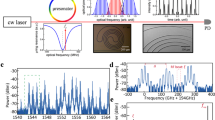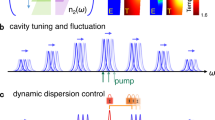Abstract
Precise measurements of the frequencies of light waves have become common with mode-locked laser frequency combs1. Despite their huge success, optical frequency combs currently remain bulky and expensive laboratory devices. Integrated photonic microresonators are promising candidates for comb generators in out-of-the-lab applications, with the potential for reductions in cost, power consumption and size2. Such advances will significantly impact fields ranging from spectroscopy and trace gas sensing3 to astronomy4, communications5 and atomic time-keeping6,7. Yet, in spite of the remarkable progress shown over recent years8,9,10, microresonator frequency combs (‘microcombs’) have been without the key function of direct f–2f self-referencing1, which enables precise determination of the absolute frequency of each comb line. Here, we realize this missing element using a 16.4 GHz microcomb that is coherently broadened to an octave-spanning spectrum and subsequently fully phase-stabilized to an atomic clock. We show phase-coherent control of the comb and demonstrate its low-noise operation.
This is a preview of subscription content, access via your institution
Access options
Subscribe to this journal
Receive 12 print issues and online access
$209.00 per year
only $17.42 per issue
Buy this article
- Purchase on Springer Link
- Instant access to full article PDF
Prices may be subject to local taxes which are calculated during checkout





Similar content being viewed by others
References
Udem, T., Holzwarth, R. & Hänsch, T. W. Optical frequency metrology. Nature 416, 233–237 (2002).
Del'Haye, P. et al. Optical frequency comb generation from a monolithic microresonator. Nature 450, 1214–1217 (2007).
Diddams, S. A., Hollberg, L. & Mbele, V. Molecular fingerprinting with the resolved modes of a femtosecond laser frequency comb. Nature 445, 627–630 (2007).
Steinmetz, T. et al. Laser frequency combs for astronomical observations. Science 321, 1335–1337 (2008).
Pfeifle, J. et al. Optimally coherent Kerr combs generated with crystalline whispering gallery mode resonators for ultrahigh capacity fiber communications. Phys. Rev. Lett. 114, 093902 (2015).
Savchenkov, A. A. et al. Stabilization of a Kerr frequency comb oscillator. Opt. Lett. 38, 2636–2639 (2013).
Papp, S. B. et al. Microresonator frequency comb optical clock. Optica 1, 10–14 (2014).
Coen, S., Randle, H. G., Sylvestre, T. & Erkintalo, M. Modeling of octave-spanning Kerr frequency combs using a generalized mean-field Lugiato–Lefever model. Opt. Lett. 38, 37–39 (2013).
Herr, T. et al. Temporal solitons in optical microresonators. Nature Photon. 8, 145–152 (2013).
Jost, J. D. et al. Counting the cycles of light using a self-referenced optical microresonator. Optica 2, 706–711 (2015).
Savchenkov, A. A. et al. Tunable optical frequency comb with a crystalline whispering gallery mode resonator. Phys. Rev. Lett. 101, 093902 (2008).
Levy, J. S. et al. CMOS-compatible multiple-wavelength oscillator for on-chip optical interconnects. Nature Photon. 4, 37–40 (2010).
Razzari, L. et al. CMOS-compatible integrated optical hyper-parametric oscillator. Nature Photon. 4, 41–45 (2010).
Ferdous, F. et al. Spectral line-by-line pulse shaping of on-chip microresonator frequency combs. Nature Photon. 5, 770–776 (2011).
Grudinin, I. S. & Yu, N. Dispersion engineering of crystalline resonators via microstructuring. Optica 2, 221–224 (2015).
Jung, H., Xiong, C., Fong, K. Y., Zhang, X. F. & Tang, H. X. Optical frequency comb generation from aluminum nitride microring resonator. Opt. Lett. 38, 2810–2813 (2013).
Hausmann, B., Bulu, I., Venkataraman, V., Deotare, P. & Loncar, M. Diamond nonlinear photonics. Nature Photon. 8, 369–374 (2014).
Yang, K. et al. Broadband dispersion-engineered microresonator on a chip. Nature Photon. 10, 316–320 (2016).
Del'Haye, P., Arcizet, O., Schliesser, A., Holzwarth, R. & Kippenberg, T. J. Full stabilization of a microresonator-based optical frequency comb. Phys. Rev. Lett. 101, 053903 (2008).
Papp, S. B., Del'Haye, P. & Diddams, S. A. Mechanical control of a microrod-resonator optical frequency comb. Phys. Rev. X 3, 031003 (2013).
Del'Haye, P., Papp, S. B. & Diddams, S. A. Hybrid electro-optically modulated microcombs. Phys. Rev. Lett. 109, 263901 (2012).
Jost, J. et al. All-optical stabilization of a soliton frequency comb in a crystalline microresonator. Opt. Lett. 40, 4723–4726 (2015).
Lee, H. et al. Chemically etched ultrahigh-Q wedge-resonator on a silicon chip. Nature Photon. 6, 369–373 (2012).
Del'Haye, P., Beha, K., Papp, S. B. & Diddams, S. A. Self-injection locking and phase-locked states in microresonator-based optical frequency combs. Phys. Rev. Lett. 112, 043905 (2014).
Del'Haye, P. et al. Phase steps and resonator detuning measurements in microresonator frequency combs. Nature Commun. 6, 5668 (2015).
Brasch, V. et al. Photonic chip-based optical frequency comb using soliton Cherenkov radiation. Science 351, 357–360 (2016).
Beha, K. et al. Self-referencing a continuous-wave laser with electro-optic modulation. Preprint at http://arxiv.org/abs/1507.06344 (2015).
Kuyken, B. et al. An octave-spanning mid-infrared frequency comb generated in a silicon nanophotonic wire waveguide. Nature Commun. 6, 6310 (2015).
Mayer, A. S. et al. Frequency comb offset detection using supercontinuum generation in silicon nitride waveguides. Opt. Express 23, 15440–15451 (2015).
Del'Haye, P. Optical Frequency Comb Generation in Monolithic Microresonators. PhD thesis, Ludwig Maximilian Univ. Munich (2011).
Del'Haye, P., Arcizet, O., Gorodetsky, M. L., Holzwarth, R. & Kippenberg, T. J. Frequency comb assisted diode laser spectroscopy for measurement of microcavity dispersion. Nature Photon. 3, 529–533 (2009).
Acknowledgements
This work is supported by the National Institute of Standards and Technology, the National Physical Laboratory, the California Institute of Technology, the Defense Advanced Research Projects Agency Quantum—Assisted Sensing and Readout programme, the Air Force Office of Scientific Research and the National Aeronautics and Space Administration. P.D. acknowledges support from the Humboldt Foundation. D.C.C. acknowledges support from the National Science Foundation Graduate Research Fellowship Program under grant no. DGE 1144083.
Author information
Authors and Affiliations
Contributions
P.D., S.B.P. and S.A.D. conceived the experiments. P.D. and A.C. designed and performed the experiments. T.F. contributed to the fceo stabilization. K.B. and D.C.C. contributed to the nonlinear spectral broadening. K.Y.Y., H.L. and K.J.V. provided the microresonator. P.D. and S.A.D. prepared the manuscript, with input from all co-authors.
Corresponding authors
Ethics declarations
Competing interests
The authors declare no competing financial interests.
Rights and permissions
About this article
Cite this article
Del'Haye, P., Coillet, A., Fortier, T. et al. Phase-coherent microwave-to-optical link with a self-referenced microcomb. Nature Photon 10, 516–520 (2016). https://doi.org/10.1038/nphoton.2016.105
Received:
Accepted:
Published:
Issue Date:
DOI: https://doi.org/10.1038/nphoton.2016.105
This article is cited by
-
Integrated frequency-modulated optical parametric oscillator
Nature (2024)
-
Nonlocal bonding of a soliton and a blue-detuned state in a microcomb laser
Communications Physics (2023)
-
Ultrastable microwave and soliton-pulse generation from fibre-photonic-stabilized microcombs
Nature Communications (2022)
-
Integrated optical frequency comb technologies
Nature Photonics (2022)
-
All-fibre heterogeneously-integrated frequency comb generation using silicon core fibre
Nature Communications (2022)



